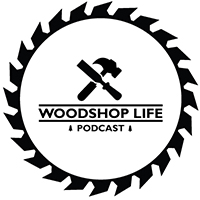Support us on Patreon: https://www.patreon.com/woodshoplife
Guy
1) I have a couple of Bessey F-Style clamps and some wooden ones made by Klemsia here in Germany (https://www.klemmsia.de). What to get next? Are parallel clamps like Bessey’s REVO really worth the extra price? Lots of people in the US seem to use pipe clamps – what’s so good about them? Are there any specialty clamps that should go into my basic kit like wooden handscrews or one handed clamps? Jarmo
2) I have seen lots of articles on making and using shooting boards but I don’t understand very well the theory behind shooting miters. How does the process work? I mean, if I make a mitered frame, and the miters aren’t perfect, what is the order or operations or the process for shooting the perfectly while maintaining the perfect length of opposing sides? As I think about it, it seems like trueing a miter also shortens the piece with will introduce a new problem and I’ll end up chasing perfection forever. Can you help me understand this?
Thank you so much! I love your show and I seriously appreciate all the effort that goes into it. All of you make my hobby even more enjoyable! – Mart
Sean
1) Hello guys, I am in the process of building my first real workbench and was wondering how you like the benches you have. I’ve seen your benches on YouTube-my questions are, how did you decide on your design/type of bench and vise styles? Is there any things you would do next time? The stuff I’m interested in is usually furniture, using mostly power tools but want to use hand tools more often. Any other discussion on the topic would be appreciated. Thanks and keep up the good work on the podcast- don’t ever change your format- it’s what makes this podcast stick out from the crowd! – Travis
2) Ihave a couple of questions about my DeWalt DW735 planer. Lately I’ve been having trouble with the planer not pulling the wood through. I’ve tried waxing the wings and bed and cleaning the rollers with mineral spirits. These help for a bit, but eventually it stops pulling the wood through again. Any ideas on what might be causing this? Brian
Huy
1) Question: I’m a diy’re and have accumulated my tools over the years. I have a Ridgid Planer and a Ridgid 6” jointer and a Delta Bandsaw 14”. They all run fine. My question is – would it be worth the money To upgrade the Ridgid machines with the helix cutters and the Bandsaw with a Carter bandsaw guides. If I did them all it would be around $1000.00. – Dave
2) How do you know when a piece of sandpaper is worn out or no longer the grit it says it is? I use high quality klingspor sanding discs that last a long time but not sure how to tell when they are no longer effective. Is there a board footage or rule of thumb you guys can talk about? – Stockbilt
